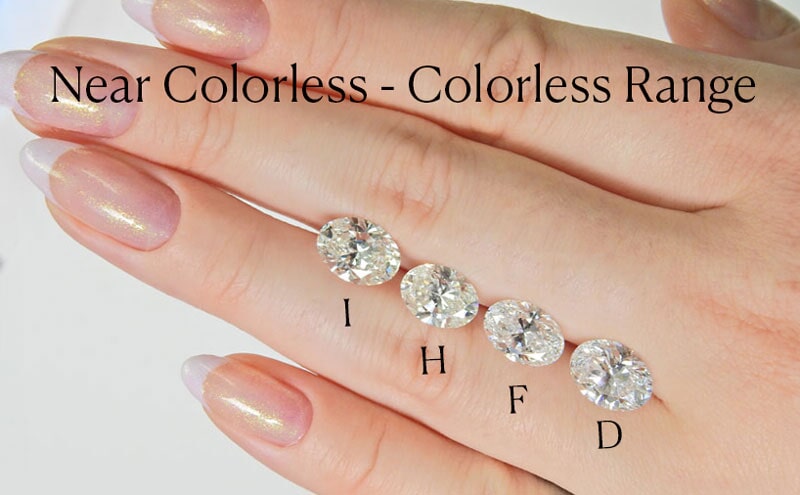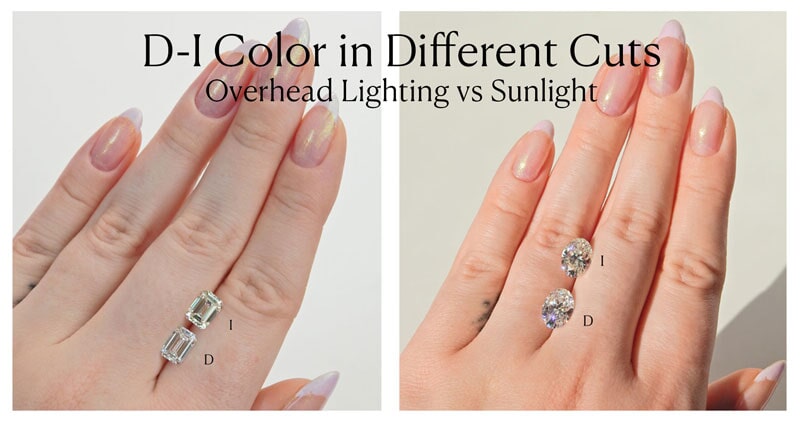The Diamond Color Chart: What It Is and Why It Matters

When it comes to diamonds, beauty isn't just in the eye of the beholder, there are industry standards in place to measure how authentic and valuable the gem really is—like the diamond color chart.
As you explore all things diamonds, you’ll inevitably come across the diamond color chart, a tool used to assess a diamond's beauty and worth. As a fundamental component of the 4Cs (Cut, Color, Clarity, Carat) it’s important to understand how it impacts what you desire in a diamond ring. In this guide we’ll explore just that, breaking down what the diamond color chart is and why it matters to your search for a quality diamond.
The Science Behind Diamond Colors
To understand the value it brings to a diamond, you must first understand why diamond color matters. Diamonds are primarily graded on a scale that measures the absence of color. The most valuable diamonds are colorless. Why? They allow the most light to pass through, adding to the sparkle that we’ve all come to love in a beautiful diamond. They are graded from D (completely colorless) to Z (noticeable color).
Colored diamonds, known as fancy diamonds, can also be deemed valuable because of their rarity and stunning hues. Think “The Heart Of The Ocean” diamond from the classic Titanic.
The color of a diamond can be affected by many factors that can include:
- Geological Processes: The presence of certain minerals during the diamond’s formation.
- Environmental Conditions: Temperature and pressure conditions during the diamond’s growth.
- Treatments: Enhancements that alter the color of the diamond.
Diamond Color Grading
Whether they are colorless or vibrant in hue, diamond colors will go through a grading process developed by The Gemological Institute of America (GIA). This scale ranges from d (colorless) to Z (light yellow or brown), and where the diamond falls on this scale is a signifier of its quality and value.
Everything You Need To Know About The Diamond Color Chart
For decades the standard for beautiful quality diamonds has been set and upheld by the GIA. As you explore the ins and outs of diamond color, you’ll likely come across the color scale that’s used throughout the industry. This scale includes grades that show the true measure of the value of a diamond. Those grades include:

- D-F: Colorless. These diamonds are extremely rare and valuable.
- G-J: Near-colorless diamonds. These have minimal color that isn’t visible to the untrained eye.
- K-M: Faint Color. The color is noticeable but still relatively light.
- N-R: Very light color. The color is more visible.
- S-Z: Light Color. These diamonds have obvious color.
Though initially the color quality is assessed by professionals, you can also get a look at just how different the different colors appear. Jewelers are happy to showcase how each grade appears in various lighting conditions. Whether that’s through comparison charts, images, or videos, you won’t be left to figure it all out on your own.
Why Diamond Color Should Matter To You
The diamond color chart is useless if you don’t see the value it brings to your search for the perfect engagement ring. When comparing diamonds in your search, consider how the color will impact the overall look and quality of your ring. Take these things into account to make the best choice for you:
- Personal preference: How much does color mean to you? Try colorless diamonds and diamonds with a slight hue to test this out.
- Setting and Metal: The setting can either highlight or minimize a diamond’s color. A Platinum setting can make a diamond appear more colorless in comparison to yellow gold which tends to compliment more color.
- Lighting Conditions: Depending on the environments, the appearance of a diamond's conditions may look different, particularly in different lighting.
Another thing to consider is how you’re shopping for a diamond. Primarily looking online? Search for high-quality images, videos, and 360-views. When planning to go in-store, ask to see the diamond under different lighting conditions and be sure to try different color grades. And no matter where you shop, it’s important to confirm your choice with a reputable certification organization like GIA, IGI, or AGS.

The 4Cs
As mentioned before, diamond color is only one component of measuring the beauty and value of this precious gem. The 4Cs is a comprehensive look into the diamond's quality. Outside of color, the 4Cs include diamond cut, clarity, and carat.
- Cut: The cut affects how well the diamond reflects light. Even with a lower color grade, a well-cut diamond can pack a lot of sparkle.
- Clarity: Clarity refers to the presence of inclusions or blemishes. Higher clarity grades mean fewer imperfections.
- Carat: Carat weight measures the size of the diamond.
It’s important to also know that all of these elements combined will also impact your budget. Whether your budget is significantly larger or you’re looking for budget-friendly options, something as simple as compromising on color can put you in a position to afford a larger or better-cut diamond.
Navigating The World of Diamond Color and Clarity Charts
Hopefully, as you dive into diamond color and clarity charts and diamonds themselves, you are confident in what you need to look for. If you use this guide and keep all of the factors mentioned in mind, you’re well on your way to finding a high-quality diamond that you not only love but fits your budget.
At Plum Diamonds, you don’t have to look far for quality diamonds. Each of our lab-grown diamonds are backed by the standards set by the 4Cs and created in an eco-friendly environment. Through our collection, you will find stunning GIA and IGI-certified diamonds that are higher on the color scale.


